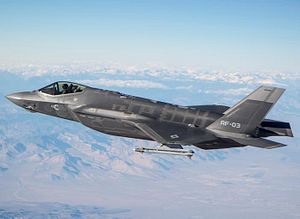Given recent North Korean provocations, the Republic of Korea (ROK) Air Force is considering purchasing 20 additional fifth-generation stealth multirole Joint Strike Fighter F-35As—the aircraft’s conventional takeoff and landing variant—in order to boost its air combat capabilities in the event of war with North Korea, according to senior ROK defense officials.
The expansion of ROK air power is currently under discussion as the South is working on a plan to simultaneously eliminate all North Korean missile bases and other key military facilities in the North in the event of a conflict. “As North Korea appears to have enhanced its nuclear and missile capabilities in recent years, we are mending our existing wartime strike programs against the North,” a ROK defense official told Yonhap news agency. The F-35A would be an integral part of this ‘knock out blow’ strategy given its ability to operate in well-defended enemy airspace due to its stealth capabilities.
South Korea and the United States signed a so-called Letter of Offer and Acceptance for the purchase of 40 F-35A fighter jets with conventional take-off and landing (CTOL) capability in September 2014 under the Pentagon’s Foreign Military Sales program. While South Korea reduced the original request from 60 to 40 aircraft, the agreement between the United States and South Korea stipulates that 20 additional F-35A fighter jets can be procured at a later stage depending on the security environment on the Korean peninsula. The ROK Air Force expects to begin deploying the first F-35As in 2018 with all 40 aircraft slated for delivery by 2021.
Lockheed Martin, the aircraft maker producing the F-35 series, won the $7 billion defense deal by promising to provide 25 technologies associated with the F-35 to help kick start South Korea’s KF-X fighter aircraft program. The objective of the $15 billion KF-X fighter program is to build 120 stealth fighter jets for the ROK Air Force and another 80 for the Indonesia Air Force (TNI-AU) between 2025 and 2030. However, the United States refused to share four (active electronically scanned radar, the infrared search-and-rescue systems, the electro-optical targeting pod and the radio frequency jammer) out of the 25 technologies.
Some analysts speculated that the Pentagon’s decision not to share the four sensitive technologies could lead to the cancellation of the entire F-35A contract. This appears to have been unfounded, although I have reported in 2015 that there are signs that South Korea is increasingly looking for European military hardware given the more lenient policies of European countries when it comes to transferring sensitive military technology (See: “Is Europe Conquering South Korea’s Defense Sector?”). Canceling the F-35A deal would leave South Korea without a fifth-generation fighter for years. Given the current security environment on the Korean peninsula, this is an unacceptable scenario for South Korean political and military leaders.
































